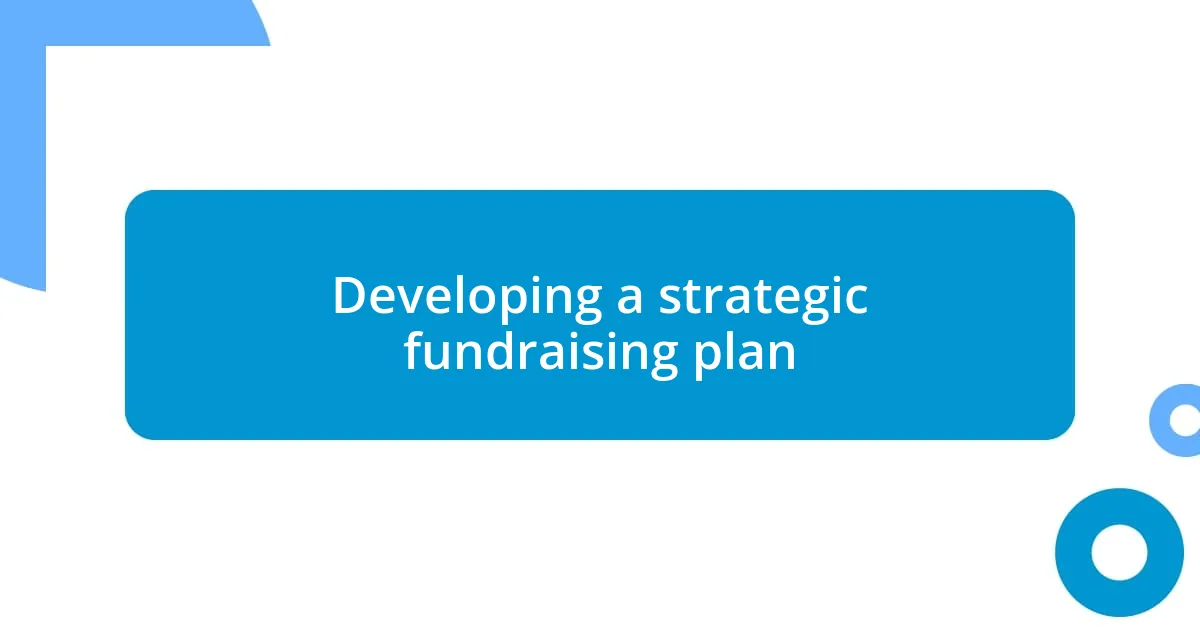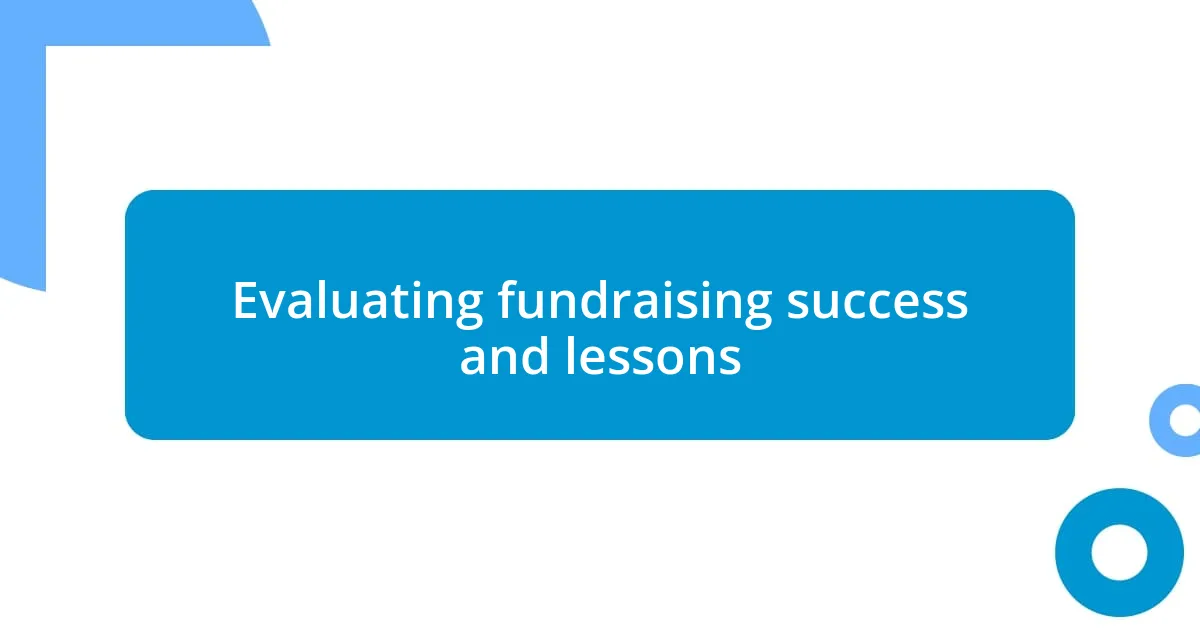Key takeaways:
- Emphasize storytelling and emotional connections to enhance donor engagement.
- Set realistic fundraising goals by understanding your audience and evaluating past efforts.
- Build genuine relationships with donors, leveraging social media for communication and visibility.
- Continuously evaluate fundraising efforts, seeking feedback and adjusting strategies based on donor behavior.

Understanding fundraising challenges
Fundraising challenges can feel overwhelming, especially when you’re passionate about your cause. I remember grappling with the fear of rejection during my first major campaign. It felt personal each time someone turned us down, making me question whether our mission resonated with anyone at all. How do we move past that initial discomfort to truly connect with potential donors?
I also discovered that competition for funding is intense. There I was, vying for attention against countless other worthy initiatives. It made me realize how crucial it is to differentiate our story. Think about it—what makes your cause stand out in a sea of similar options? Crafting a compelling narrative became essential for me; it was about showing the potential impact rather than just asking for money.
Moreover, I faced the challenge of building trust. I often wondered, “How can potential donors believe in our vision if they don’t know us?” Taking the time to foster relationships became vital. By sharing our progress and struggles transparently, I found that authenticity resonates with people more than any polished pitch ever could. In my experience, being open about both successes and setbacks has created a deeper connection with our supporters.

Setting realistic fundraising goals
When I first started fundraising, one of the biggest lessons I learned was the importance of setting realistic goals. Initially, I was overly ambitious, dreaming of raising thousands in a matter of weeks. But as I plunged into the work, I realized that having achievable targets not only made the process less daunting but also helped maintain team morale. Each small milestone celebrated along the way kept our spirits high and motivated us to keep pushing forward.
Here are some strategies that helped me set realistic fundraising goals:
– Know Your Audience: Understanding donor capacity and willingness can guide your targets.
– Evaluate Past Campaigns: Reflect on previous fundraising efforts; they often reveal what’s possible.
– Break It Down: Divide larger goals into smaller, manageable chunks.
– Consider Time Constraints: Assess how much time you can realistically dedicate to fundraising.
– Factor in Resources: Account for the resources—time, money, and manpower—at your disposal.
For me, each goal reached became a stepping stone. I recall one campaign where we aimed to raise $5,000 over a month. By breaking it down and actively engaging our community, we exceeded our target. That experience taught me that realistic, yet aspirational, goals can change the fundraising game.

Crafting a compelling fundraising message
Crafting a compelling fundraising message is all about storytelling. From my experience, the emotional resonance of a narrative can truly capture attention. I once shared a heartfelt story of a local family positively impacted by our initiative, and it sparked an incredible wave of support. The difference was palpable—the moment I started focusing on the individuals affected by our work rather than just the mission, I felt a shift in how people connected with our cause. Isn’t it fascinating how a personal touch can transform a fundraising appeal?
In my journey, I also learned that clarity is paramount. If your message is muddled or confusing, potential donors simply won’t engage. I recall revising our pitch multiple times, ensuring we highlighted the urgency of the situation and the tangible outcomes. By presenting a clear, concise, and compelling message, I witnessed increased interest and involvement from potential supporters. It’s like painting a vivid picture of what their contribution can achieve. Wouldn’t you agree that simplicity often outshines complexity in communication?
Finally, I realized the power of a strong call to action. Without it, your message risks fading into the background. I vividly remember one campaign where I emphasized the direct impact of a $100 donation, showing how it could provide essential resources for ten families. The response was incredible, and donations poured in. Crafting that message taught me that when potential donors know exactly how they can make a difference, they’re more likely to take action.
| Key Elements | Description |
|---|---|
| Storytelling | Using personal narratives to create emotional connections with potential donors. |
| Clarity | Ensuring the message is straightforward and easily understood to maintain engagement. |
| Call to Action | Providing a clear directive that illustrates the impact of contributions, encouraging immediate support. |

Building a strong donor network
Building a strong donor network is essential for successful fundraising. In my experience, the connections I nurtured often turned into invaluable partnerships. I vividly remember attending a community event where I struck up a casual conversation with a local business owner. This simple exchange blossomed into a lasting relationship, and they eventually became one of our most dedicated supporters. Have you ever wondered how personal interactions can transform into significant support?
Networking isn’t just about collecting contacts; it’s about building genuine relationships. I often find myself reaching out to past donors not just to ask for contributions but to catch up and share successes. One time, I reached out to a large donor after a successful project to personally thank them—this gesture reinforced their commitment, and they even increased their contributions in the following campaigns. Doesn’t it feel great when you can create such a meaningful connection?
Social media has also played a pivotal role in expanding my donor network. I discovered that sharing our milestones and honoring donors online fostered a sense of community and visibility. For instance, after posting about a successful campaign, I received messages from friends of friends who were inspired to support our work. This ripple effect illustrated just how powerful our networks can be if we approach them with authenticity. It begs the question: how can we leverage our own networks to amplify our fundraising efforts?

Developing a strategic fundraising plan
Developing a strategic fundraising plan is an essential step that can significantly shape your fundraising outcomes. I found that starting with a clear goal made all the difference—it’s like setting your GPS before a journey. When we aimed to raise $50,000 for our community center renovations, every action we took was geared towards that target. How often do we find ourselves adrift without a clear destination in mind?
In addition, I realized the importance of identifying and understanding your target audience. I remember dedicating time to segmenting our potential donors into different groups based on their interests and past contributions. This allowed me to tailor our outreach effectively. For example, when reaching out to local businesses, I highlighted how their support could boost their visibility in the community. Isn’t it amazing how a little personalization can lead to a much warmer reception?
Lastly, incorporating a timeline for your fundraising activities is crucial. Planning our events month-by-month not only helped keep the team organized but also made it easier to engage with potential donors over time. One particularly successful strategy involved a series of small engagement events leading up to our big gala night, gradually building excitement and connection. Reflecting on this, I wonder how many organizations overlook the power of incremental engagement in their fundraising strategies.

Leveraging social media for outreach
Social media has truly become a game-changer in my fundraising efforts. I discovered that sharing impactful stories can ignite passion and engagement among potential donors. For example, I once shared a heartfelt video showcasing the direct impact of our work on the community. The responses were overwhelming; people felt connected and compelled to contribute. Have you noticed how visuals can create a strong emotional pull?
On platforms like Instagram and Facebook, I found that the immediacy of communication allowed me to foster deeper connections with my audience. I often engaged with followers through polls or live Q&A sessions, inviting them into the conversation. When I hosted a live session discussing our latest project, my social media followers not only tuned in but also began sharing the post among their networks—expanding our outreach exponentially. Isn’t it remarkable how a simple conversation can ripple outwards?
With each post and tweet, I realized that consistency is key. I made it a habit to share updates regularly, highlighting donor contributions and celebrating milestones. One morning, after posting about a smaller fundraising initiative, I was pleasantly surprised to see a surge in donations. The visibility we created made donors feel valued—they weren’t just faceless contributors; they were part of a larger mission. This made me ponder, how much more impact could we have if we fully embraced the storytelling potential of social media?

Evaluating fundraising success and lessons
Evaluating fundraising success is about more than just numbers. I remember wrapping up our campaign and sitting down to analyze the results with my team. We didn’t just look at the total amount raised; we discussed what worked and what fell short. One unexpected lesson was realizing how some of our lower-performing outreach methods still had significant engagement, leading to new connections that could benefit future campaigns. Have you ever been surprised by the hidden value in your efforts?
In reflecting on lessons learned, I found that feedback was incredibly valuable. After our main fundraising event, we sent out a survey to attendees to gauge their experience and gather suggestions. The responses were eye-opening—many offered insights into enhancing engagement and improving future events. I had never considered how a simple request for feedback could spark deeper relationships with our supporters. It made me wonder, are we doing enough to listen to our community’s voice?
Lastly, I started recognizing patterns in donor behavior that helped shape our approach moving forward. For instance, I noticed a strong correlation between the timing of our outreach and donor responsiveness. After analyzing our data, we adjusted future campaigns to align with when our supporters were most active and engaged. This analytical approach transformed our strategy, making the relationship with our donors feel more like a conversation than a transaction. How often do we actually take the time to listen and adjust based on what our supporters are telling us?














